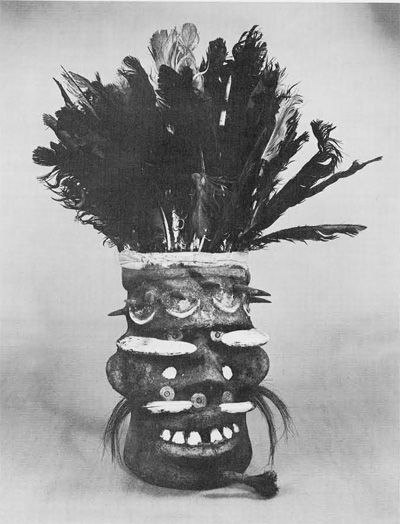
A powerful fetish that also served as an oracle in the Kra or Tchien tribe of Liberia has recently been given to our African Gallery by Allen Clayton Davis, who acquired it in 1959 when serving as Second Secretary and Political Officer in the U.S. Embassy at Monrovia, Liberia.
A larger-than-life black pottery head, widely grinning but fiercely menacing, it is fantastically decorated with the horns, teeth, tusks, feathers, hair, and quills of seven different West African animals. In addition, two bits of white porcelain serve as eyes and a row of brass shotgun shell caps trim the upper lip, thus including some of the white man’s magic. A fetish, by definition, must embody as much power as possible, so this extraordinary assemblage of the excrescences of animals admired or feared for their intelligence, cunning, ferocity, protectiveness, or social organization has surely added strength to the great fetish. Crowned with an explosion of hornbill feathers and a single porcupine quill, bound tightly with brownish cloth, it has a row of pygmy antelope horns, spiking at right angles to the forehead, directly below the crown. Beneath the horns, bush pig or wart hog tusks are imbedded deeply in the brow, and a pair of pygmy hippopotamus teeth, curving forward from each ear, almost meet across the nose. There’s a mustache of long black cow tail hair which falls over a second pair of hippo teeth, and the big square teeth of the thick-lipped mouth are those of the bush cow or West African buffalo. Between the teeth drops a twisted raphia string to which is attached the “voice” or tongue of the fetish, a small bundle of short hornbill feathers.
Dr. George W. Harley, who spent over 30 years as a medical missionary among the Gio of Liberia, (of which the Kra or Tchien is a sub-tribe) says the fetish is called Ga Sua by the tribesmen; he considers it the finest example he has seen. Questioned about the kind of clay used in its making, Dr. Harley said the Gio people used the nests or termitaria of just one special variety of termite. These are steeple or stalagmite-like structures, two or three feet in height, composed of grains of soil cemented together with the saliva and fecal matter of the termites to a hardness as great as concrete and completely invulnerable to termite chewing. The Gio locate such a termitarium, remove the queen, a great white grub the size of a large shrimp and usually swollen with eggs, and then put the nest, clubbed into large chunks, to soak in a tub of water, mashing it up every day until it reaches the consistency of putty. Then, kneaded into a malleable mass, it is used for pots of various types and especially for fetishes and charms. These are sun or fire-dried to the original cement hardness of the termitarium. Perhaps the strength and power of the finished fetish are augmented by smearing it with the crushed body of the queen ant, she, making millions of termites a month, being the very embodiment of fertility. But very often, being a tasty delicacy when fried in her own fat, in Africa (as in Indonesia), she is eaten.
The center section of the hornbill crown of our fetish lifts out; it is a tightly fitting lid for a shallow cavity within, in which many charms and “medicines” are secreted. The surface of the fetish is scabrous and black, from the dried blood and other substances of the many animals and birds that have been sacrificed over it to add to its power.
Mr. Davis acquired the fetish by a feat of serendipity at the time the first modern road was being built at the southern tip of Liberia, where it will eventually connect with a road in the Ivory Coast. Mr. Davis was accompanied to this area by two colleagues from the Embassy and by his Mandingo boy, Talaby, who spoke Gio. Knowing Mr. Davis’s interest in African sculpture, Talaby scouted about the small village near the road construction and later led his master to the hut where this big fetish “lived” with two smaller attendant fetishes on a rectangular mud altar. The Mandingo boy had not only discovered that this was the most powerful fetish for miles around but that it was also a famous oracle. The fetish priest was a ventriloquist who could make the fetish apparently answer questions and give opinions, act as a judge in tribal disputes, and suggest omens, good or bad. Admiring the fetish enthusiastically, Mr. Davis and his friends from Monrovia continued their walk about the village.
Soon after, ready for the return drive to Monrovia, Talaby joined him, carrying a huge parcel wrapped in fresh palm leaves. He was surrounded by a crowd of laughing, cheering, dancing, and singing villagers. Questioned, the Mandingo refused to reveal the contents of his bundle, but after driving a few miles, he unwrapped it and there was the great fetish. Scolded by Mr. Davis for tricking the villagers, he was ordered to return it at once; but Talaby insisted that the villagers were glad to see the fetish go, that they had told him that it had already “flown” once to Monrovia where it had identified with a witch who was “humbugging” or making life difficult for the President, and it had then “flown” home when its mission had been accomplished. The Mandingo boy had, he admitted, suggested that there were other witches active in Monrovia against whom the fetish could be used, but he insisted that the men forced the fetish upon him and explained that Ga Sua (or the village fetish priest) had grown too powerful over a period of years for the comfort of the tribe–that the fetish knew too much.
